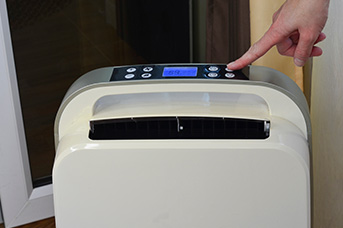
Dehumidifier Installation in New Jersey
Living in New Jersey can often mean experiencing high levels of humidity throughout the year. Having too much moisture is not just uncomfortable, it can lead to pest infestations. A common solution to combat high humidity in the home is to install a dehumidifier. A dehumidifier is a powerful tool to help bring down moisture in the air. Once the dehumidifier detects the home is above the preferred range, the unit will turn on and begin running a fan. This fan pulls in the humid air and condenses it into a bucket of water for removal. Some machines can remove up to 100 pints a day of moisture! Keep reading below to make sure that your home has safe levels of humidity.
What are Dehumidifiers and Why Would You Need One?
If you have a basement or crawlspace in your home, it is important to monitor signs of dampness in those areas. The ideal humidity level for a home is between 30-60%, and once you go over that 60% your home becomes susceptible to numerous health and home hazards. What are the signs of too much humidity in your home?
- Musty Smell
- Mold/Mildew
- Damp or Wet Walls
- Peeling Paint
- Efflorescence (salt deposits)
- Wood Rot
- Condensation
If you notice any of these signs, you may need a dehumidifier to protect yourself and your home. What are some side effects of too much moisture in your home?
- Wood rot
- Unwanted bugs
- Hidden Damage on the upper floors of the home
- Dust allergies (caused by dust mites)
- Respiratory problems (including asthma, difficulty breathing, faintness, poor concentration)
- Electronic malfunctions
Placement and Types of Dehumidifiers
There are several considerations for choosing the appropriate dehumidifier. If you need any help with dehumidifier selection and installation, choose the experts at Cooper Pest Solutions. Listed below are some of the main points to consider:
- Room Size: Do you need one room or an entire house to care for? You can purchase a whole house unit, or a portable unit if the problem area is localized. A general suggestion is to do a 10-pint dehumidifier for the initial 500 square feet, with four pints added for each additional 500 square feet.
- Drainage: You can have a unit that drains independently through a hose or a manual bucket that you can dump yourself.
- Low-temperature operation: If you put the unit in a basement or crawl space, make sure it can function well in cold temperatures. It can also be labeled as a unit with an automatic defrost.
- Air filter: Some units also have air filters to help trap allergens and dust.
- Placement: The ideal spaces to place a dehumidifier include your basement, crawl space, bathroom, or laundry room.
How to Maximize the Benefits of a Dehumidifier?
When using a dehumidifier, you can naturally eliminate the negative side effects that can occur over time in damp rooms. You can also take extra steps to maximize energy-saving and eco-friendly practices. For example, only run your dehumidifier when necessary and make sure that you have a unit that is not too large for your needs. You can also upgrade to an Energy Star unit, as it is a more efficient, low-energy option. By considering these factors, you can stretch every penny that goes into running your dehumidifier.
Need Help Installing? Call Us!
Too much moisture in the home has consequences that are just not worth it! By installing a dehumidifier, you can help prevent costly home repairs and keep your family safe. At Cooper Pest Solutions, we provide professional installation of dehumidifiers in your home. Reach out today so we can help you tackle your humidity problems!


